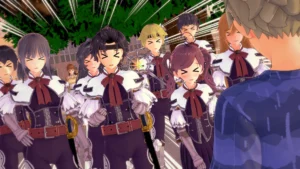
How I Became the Bodyguard of the Saintess!
Play How I Became the Bodyguard of the Saintess!
How I Became the Bodyguard of the Saintess! review
Exploring the Fantasy Romance Visual Novel’s Unique Mechanics
Discover the captivating world of ‘How I Became the Bodyguard of the Saintess!’, a fantasy visual novel blending magical adventures with heartfelt relationships. This analysis explores the game’s unique structure combining childhood friendship dynamics with high-stakes fantasy conflicts, while examining how player choices shape romantic outcomes in a realm threatened by dark forces.
Core Narrative Framework
Protagonist’s Unlikely Hero Journey
Picture this: you’re a broke magic academy dropout 🎓, scraping by as a mercenary, when suddenly—boom—you’re handed a glowing holy relic and told you’re the only one who can protect the nation’s beloved Saintess. Oh, and she just happens to be your childhood best friend who used to throw mud at you during village festivals. 😂 That’s the gloriously messy setup of How I Became the Bodyguard of the Saintess!, where fantasy romance mechanics turn everyday choices into world-shaping decisions.
What makes the protagonist’s journey so addictive? It’s all about balance. You’re not some chosen-one demigod—you’re a sarcastic underdog with a sword and a chip on your shoulder. Your growth comes through key decision points that blend tactical combat (think magic knight conflicts over tea parties 🍵⚔️) with emotional gut-punches. During my first playthrough, I accidentally triggered a “rival knight ambush” scene because I prioritized buying healing potions over attending a prayer ritual. Whoops.
Here’s the kicker: your stats literally shape dialogue. Max out “Loyalty” early? The Saintess starts teasing you about being “clingy.” Focus on “Combat Magic”? Prepare for spicy arguments about whether brute force trumps divine wisdom. 💥 The game’s divine protector role isn’t just a title—it’s a personality test disguised as a sword-swinging simulator.
Childhood Bonds Versus Divine Duty
Let’s talk about the elephant in the cathedral: the childhood friends dynamic that’s equal parts heartwarming and heartbreaking. 🐘❤️🔥 The Saintess isn’t some distant deity—she’s the girl who helped you cheat on magic exams and still laughs at your terrible jokes. But now she’s got celestial responsibilities, and you’re the grumpy bodyguard rolling your eyes at her “holy speeches.”
The genius here? Every nostalgic memory you unlock (like finding her old ribbon 🎀 or revisiting your village’s burnt-down treehouse) directly impacts her “Faith” meter. Push too hard for “the old days,” and she’ll shut down, prioritizing her divine role. But ignore her spiritual struggles, and she becomes emotionally distant. In my second playthrough, I balanced both by choosing options like, “You’re still terrible at knitting, Your Holiness” —which earned me a rare blush sprite AND kept her divine resolve intact.
💡 Pro Tip: Use the “Shared History” menu to replay flashbacks. Certain choices here unlock secret routes where you can challenge her divine duties head-on!
The game forces you to ask: Can love survive when one of you is literally married to the heavens? 🌌 The answer depends on how you juggle magic knight conflicts (like defending her from assassins) with quieter moments where you’re just two idiots stealing pastries from the temple kitchen. 🥮
Worldbuilding Through Magical Conflicts
Forget dusty lore dumps—How I Became the Bodyguard of the Saintess! builds its world through magic knight conflicts that feel personal. Every battle is a political minefield. Protect a corrupt noble to avoid war? Let rebels kidnap the Saintess to expose corruption? The game’s fantasy romance mechanics tie military strategy to relationship stakes. Lose too many soldiers, and the Saintess withdraws into self-blame. Win without mercy, and she questions your morality.
The magic system itself reflects this tension. Your “holy knight” abilities grow stronger when aligned with the Saintess’s faith, but rebel mages offer forbidden dark spells that strain your bond. During a late-game siege, I used a forbidden ice spell to save her—only to watch her cry over the frozen corpses of enemies she’d hoped to redeem. ❄️😢
| Heroine Type | Classic Trope | This Game’s Twist |
|---|---|---|
| Childhood Friend | Supports MC passively | Must balance MC’s loyalty with divine destiny |
| Saintess | Untouchable ideal | Secretly rebellious, struggles with doubt |
| Rival Knight | One-note antagonist | Becomes ally if you respect their honor code |
Why This Framework Works
The game’s core narrative framework succeeds because it makes you feel the weight of every role: the protector, the friend, the soldier. With 38 story branches and 17 key decision points, no two playthroughs are the same. My favorite moment? When I skipped a main quest to help the Saintess rescue a stray cat 🐈⬛, which later triggered a scene where she defies her priests to save a village. “You taught me courage isn’t just about grand battles,” she says. Cue the ugly crying.
So, should you play this? If you want a fantasy romance mechanics masterclass where saving the world feels as intimate as sharing a childhood secret—absolutely. Just keep tissues handy. 😭✨
This fantasy visual novel successfully merges magical warfare with nuanced relationship building through its innovative route system. Players seeking story-driven experiences with meaningful choices will find depth in the protagonist’s journey from ordinary citizen to legendary protector. Follow developer updates for upcoming harem route expansions and enhanced scene variations.
















